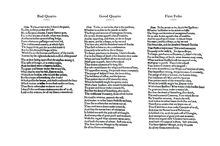
The Tragedy of Hamlet, Prince of Denmark, often shortened to Hamlet, is a tragedy written by William Shakespeare sometime between 1599 and 1601. It is Shakespeare's longest play, with 29,551 words. Set in Denmark, the play depicts Prince Hamlet and his attempts to exact revenge against his uncle, Claudius, who has murdered Hamlet's father in order to seize his throne and marry Hamlet's mother. Hamlet is considered among the "most powerful and influential tragedies in the English language", with a story capable of "seemingly endless retelling and adaptation by others". It is widely considered one of the greatest plays of all time. Three different early versions of the play are extant: the First Quarto ; the Second Quarto ; and the First Folio. Each version includes lines and passages missing from the others.

Shakespearean tragedy is the designation given to most tragedies written by playwright William Shakespeare. Many of his history plays share the qualifiers of a Shakespearean tragedy, but because they are based on real figures throughout the history of England, they were classified as "histories" in the First Folio. The Roman tragedies—Julius Caesar, Antony and Cleopatra and Coriolanus—are also based on historical figures, but because their sources were foreign and ancient, they are almost always classified as tragedies rather than histories. Shakespeare's romances were written late in his career and published originally as either tragedy or comedy. They share some elements of tragedy, insofar as they feature a high-status central character, but they end happily like Shakespearean comedies. Almost three centuries after Shakespeare's death, the scholar F. S. Boas also coined a fifth category, the "problem play," for plays that do not fit neatly into a single classification because of their subject matter, setting, or ending. Scholars continue to disagree on how to categorize some Shakespearean plays.

The earliest texts of William Shakespeare's works were published during the 16th and 17th centuries in quarto or folio format. Folios are large, tall volumes; quartos are smaller, roughly half the size. The publications of the latter are usually abbreviated to Q1, Q2, etc., where the letter stands for "quarto" and the number for the first, second, or third edition published.

Hamlet is a 1996 British epic historical drama film and an adaptation of William Shakespeare's play Hamlet, adapted and directed by Kenneth Branagh, who also stars as Prince Hamlet. The film also features Derek Jacobi as King Claudius, Julie Christie as Queen Gertrude, Kate Winslet as Ophelia, Michael Maloney as Laertes, Richard Briers as Polonius, and Nicholas Farrell as Horatio. Other cast members include Robin Williams, Gérard Depardieu, Jack Lemmon, Billy Crystal, Rufus Sewell, Charlton Heston, Richard Attenborough, Judi Dench, John Gielgud and Ken Dodd.

Richard III is a play by William Shakespeare. It was probably written c. 1592–1594. It is labelled a history in the First Folio, and is usually considered one, but it is sometimes called a tragedy, as in the quarto edition. Richard III concludes Shakespeare's first tetralogy and depicts the Machiavellian rise to power and subsequent short reign of King Richard III of England.
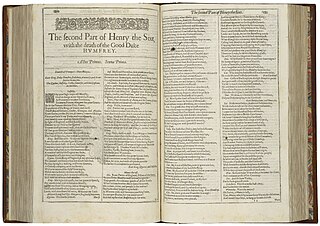
Henry VI, Part 2 is a history play by William Shakespeare believed to have been written in 1591 and set during the lifetime of King Henry VI of England. Whereas Henry VI, Part 1 deals primarily with the loss of England's French territories and the political machinations leading up to the Wars of the Roses, and Henry VI, Part 3 deals with the horrors of that conflict, 2 Henry VI focuses on the King's inability to quell the bickering of his nobles, the death of his trusted adviser Humphrey, Duke of Gloucester, the rise of the Duke of York and the inevitability of armed conflict. As such, the play culminates with the opening battle of the War, the First Battle of St Albans (1455).

Polonius is a character in William Shakespeare's play Hamlet. He is chief counsellor of the play's ultimate villain, Claudius, and the father of Laertes and Ophelia. Generally regarded as wrong in every judgment he makes over the course of the play, Polonius is described by William Hazlitt as a "sincere" father, but also "a busy-body, [who] is accordingly officious, garrulous, and impertinent". In Act II, Hamlet refers to Polonius as a "tedious old fool" and taunts him as a latter day "Jephtha".

A Yorkshire Tragedy is an early Jacobean era stage play, a domestic tragedy printed in 1608. The play was originally assigned to William Shakespeare, though the modern critical consensus rejects this attribution, favouring Thomas Middleton.

Shakespeare's plays are a canon of approximately 39 dramatic works written by English poet, playwright, and actor William Shakespeare. The exact number of plays as well as their classifications as tragedy, history, comedy, or otherwise is a matter of scholarly debate. Shakespeare's plays are widely regarded as among the greatest in the English language and are continually performed around the world. The plays have been translated into every major living language.
"Mortal coil" is a poetic term for the troubles of daily life and the strife and suffering of the world. It is used in the sense of a burden to be carried or abandoned. To "shuffle off this mortal coil" is to die, exemplified in the "To be, or not to be" soliloquy in Shakespeare's Hamlet.

Prince Hamlet is the title character and protagonist of William Shakespeare's tragedy Hamlet (1599–1601). He is the Prince of Denmark, nephew to the usurping Claudius, and son of King Hamlet, the previous King of Denmark. At the beginning of the play, he is conflicted whether, and how, to avenge the murder of his father, and struggles with his own sanity along the way. By the end of the tragedy, Hamlet has caused the deaths of Polonius, Laertes, Claudius, and Rosencrantz and Guildenstern, two acquaintances of his from childhood. He is also indirectly involved in the deaths of his love Ophelia (drowning) and of his mother Gertrude.
William Shakespeare's play Hamlet has contributed many phrases to common English, from the famous "To be, or not to be" to a few less known, but still in everyday English.
"What a piece of work is a man!" is a phrase within a monologue by Prince Hamlet in William Shakespeare's play Hamlet. Hamlet is reflecting, at first admiringly, and then despairingly, on the human condition.
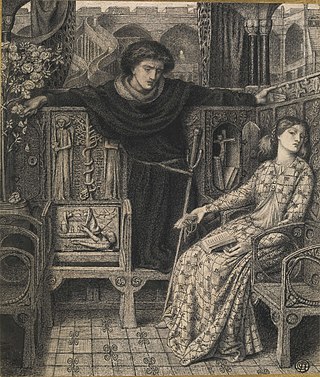
From its premiere at the turn of the 17th century, Hamlet has remained Shakespeare's best-known, most-imitated, and most-analyzed play. The character of Hamlet played a critical role in Sigmund Freud's explanation of the Oedipus complex. Even within the narrower field of literature, the play's influence has been strong. As Foakes writes, "No other character's name in Shakespeare's plays, and few in literature, have come to embody an attitude to life ... and been converted into a noun in this way."
What follows is an overview of the main characters in William Shakespeare's Hamlet, followed by a list and summary of the minor characters from the play. Three different early versions of the play survive: known as the First Quarto ("Q1"), Second Quarto ("Q2"), and First Folio ("F1"), each has lines—and even scenes—missing in the others, and some character names vary.

Rosencrantz and Guildenstern, A Tragic Episode, in Three Tabloids is a short parody play by W. S. Gilbert of Hamlet by William Shakespeare. The main characters in Gilbert's play are King Claudius and Queen Gertrude of Denmark, their son Prince Hamlet, the courtiers Rosencrantz and Guildenstern, and Ophelia.

Ophelia is a character in William Shakespeare's drama Hamlet (1599–1601). She is a young noblewoman of Denmark, the daughter of Polonius, sister of Laertes and potential wife of Prince Hamlet, who, due to Hamlet's actions, ends up in a state of madness that ultimately leads to her drowning.
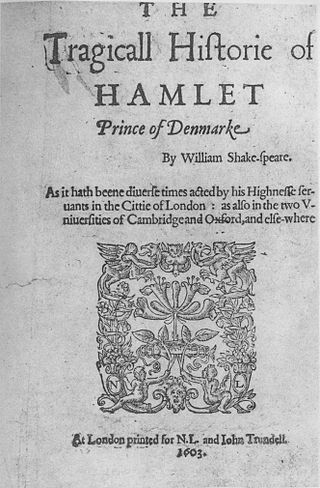
Q1 of Hamlet is a short early text of the Shakespearean play. The intended publication of the play is entered in the Stationers' Register in 1602 by James Roberts, but Q1 was not published until summer or autumn 1603. It was published by the booksellers Nicholas Ling and John Trundell, and printed by Valentine Simmes. Roberts later printed the "Second Quarto" (Q2).
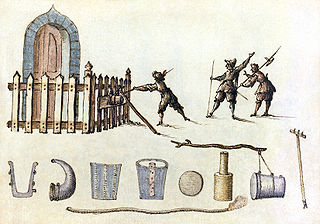
"Hoist with his own petard" is a phrase from a speech in William Shakespeare's play Hamlet that has become proverbial. The phrase's meaning is that a bomb-maker is blown off the ground by his own bomb ("petard"), and indicates an ironic reversal or poetic justice.
